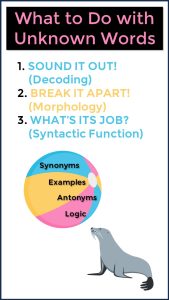Teaching Reading Comprehension
As more teachers are teaching reading strategies (all helpful) to help students access, understand, and analyze text independently, let’s not overlook the obvious: How to Improve Reading Comprehension.
As a reading specialist, I am constantly surprised by teachers who tell me that they have never learned how to teach reading comprehension or think that reading strategies alone will do the job. If you’ve never learned how to teach reading comprehension, the following advice and FREE Resources are just what the doctor ordered.
Despite what many believe, reading is not a natural process; it needs to be taught, and not just caught.
A reader’s comprehension of any text (narrative or expository) depends upon the quality of the internal dialogue between the reader and author. “Talking to the text” significantly increases reader comprehension and promotes retention as well. Tons of reading research on this. Check out my Pennington Publishing Blog for dozens of articles on this. However, reader-author dialogue is not a skill acquired by osmosis. It requires instruction and practice. Doesn’t everything?
The most effective approach to helping students learn to interact with the text is to teach students how to begin and carry on the conversation with the author. Specific cueing strategies prompt the reader to talk to the text and the author. These cueing strategies assign readers a set of tasks to perform while reading to maintain interactive dialogue with the text.
I’ve developed five cueing strategies, using the SCRIP acronym, which work equally well with narrative and expository text. The SCRIP acronym stands for Summarize, Connect, Re-think, Interpret, and Predict. Teaching students to question the text they read by prompting themselves with the SCRIP strategies will help them understand and better remember what they read. Click here to get three great resources absolutely FREE: 1. SCRIP classroom posters 2. Five one-page fairy tales to teach each of the SCRIP strategies 3. SCRIP bookmarks.
Get the SCRIP Comprehension Strategies FREE Resource:
![]()
Here’s how to use those resources: Do a Think-Aloud to teach students how you carry on the conversation with an author. Start with the each of the five fairy tales to focus on one SCRIP strategy per lesson.
- Tell students that you are going to demonstrate what good readers do as they silently read.
- Read a few lines out loud and then alter your voice (raise the pitch, lower the volume, or use an accent) to model what you are thinking. Stop and explain what the voice altering meant and keep this voice altering consistent throughout the Think-Aloud.
- Prompt your dialogue with the focus SCRIP strategy. Use this specific language of instruction.
- Don’t over-do the amount of your Think-Aloud thoughts. Once or twice per every paragraph is about right. Don’t interrupt the flow of the reading.
- Have students read the same fairy tale as a “pair share.” One student reads a paragraph out loud and does a Think-Aloud, referencing their SCRIP bookmark to prompt their dialogue with the author. Then the next reads a paragraph, etc.
- De-brief. Ask students if they think they understood the text better because of your verbalized thoughts (and theirs) rather than just by passively reading without talking to the text.
- Select your own reading and do a Think-Aloud, using all five of the SCRIP strategies
The Science of Reading Intervention Program
The Science of Reading Intervention Program: Word Recognition includes explicit, scripted instruction and practice with the 5 Daily Google Slide Activities every reading intervention student needs: 1. Phonemic Awareness and Morphology 2. Blending, Segmenting, and Spelling 3. Sounds and Spellings (including handwriting) 4. Heart Words Practice 5. Sam and Friends Phonics Books (decodables). Plus, digital and printable sound wall cards and speech articulation songs. Print versions are available for all activities. First Half of the Year Program (55 minutes-per-day, 18 weeks)
The Science of Reading Intervention Program: Language Comprehension resources are designed for students who have completed the word recognition program or have demonstrated basic mastery of the alphabetic code and can read with some degree of fluency. The program features the 5 Weekly Language Comprehension Activities: 1. Background Knowledge Mentor Texts 2. Academic Language, Greek and Latin Morphology, Figures of Speech, Connotations, Multiple Meaning Words 3. Syntax in Reading 4. Reading Comprehension Strategies 5. Literacy Knowledge (Narrative and Expository). Second Half of the Year Program (30 minutes-per-day, 18 weeks)
The Science of Reading Intervention Program: Assessment-based Instruction provides diagnostically-based “second chance” instructional resources. The program includes 13 comprehensive assessments and matching instructional resources to fill in the yet-to-be-mastered gaps in phonemic awareness, alphabetic awareness, phonics, fluency (with YouTube modeled readings), Heart Words and Phonics Games, spelling patterns, grammar, usage, and mechanics, syllabication and morphology, executive function shills. Second Half of the Year Program (25 minutes-per-day, 18 weeks)
The Science of Reading Intervention Program BUNDLE includes all 3 program components for the comprehensive, state-of-the-art (and science) grades 4-adult full-year program. Scripted, easy-to-teach, no prep, no need for time-consuming (albeit valuable) LETRS training or O-G certification… Learn as you teach and get results NOW for your students. Print to speech with plenty of speech to print instructional components.
Literacy Centers, Reading, Spelling/Vocabulary, Study Skills

